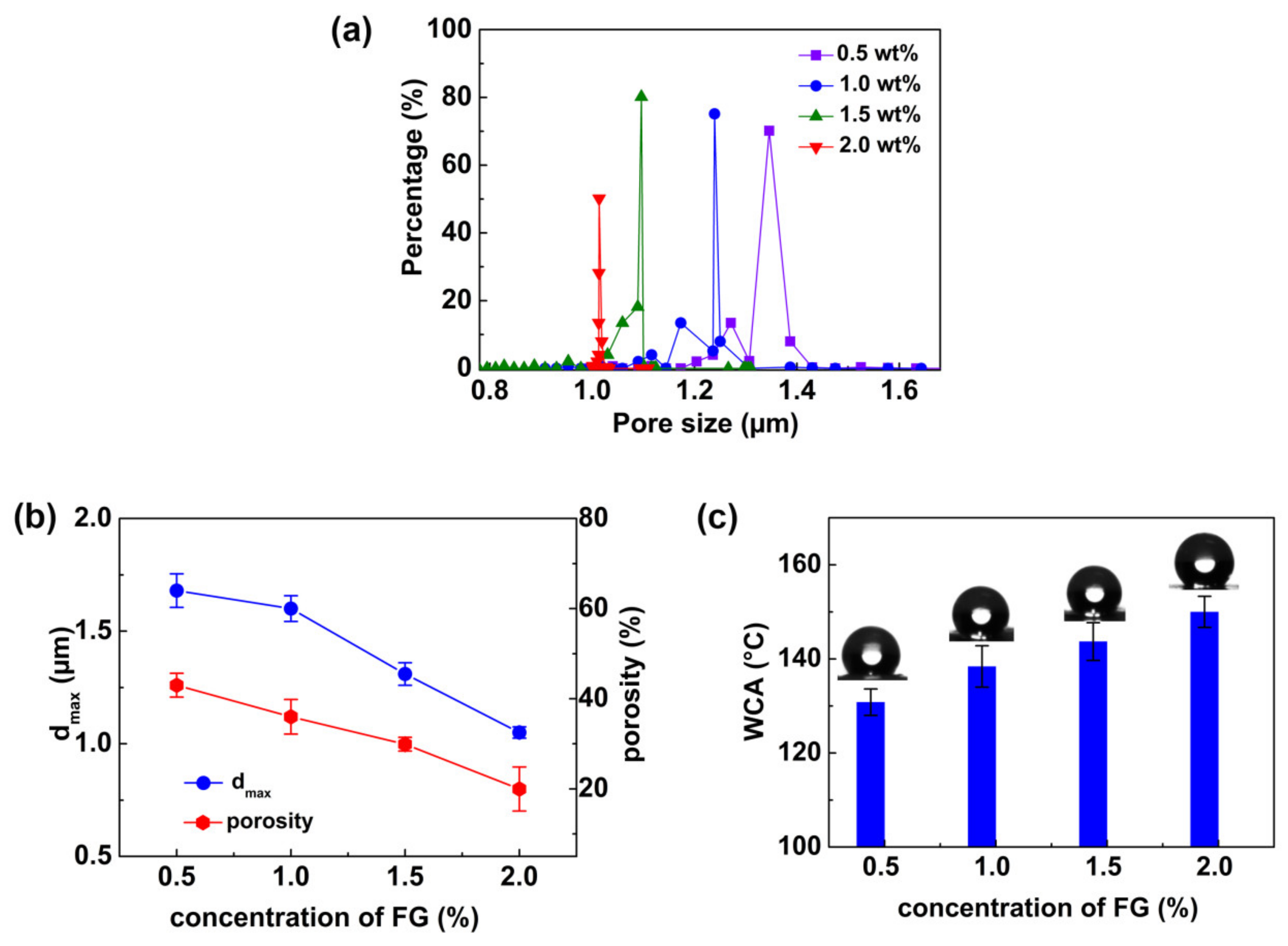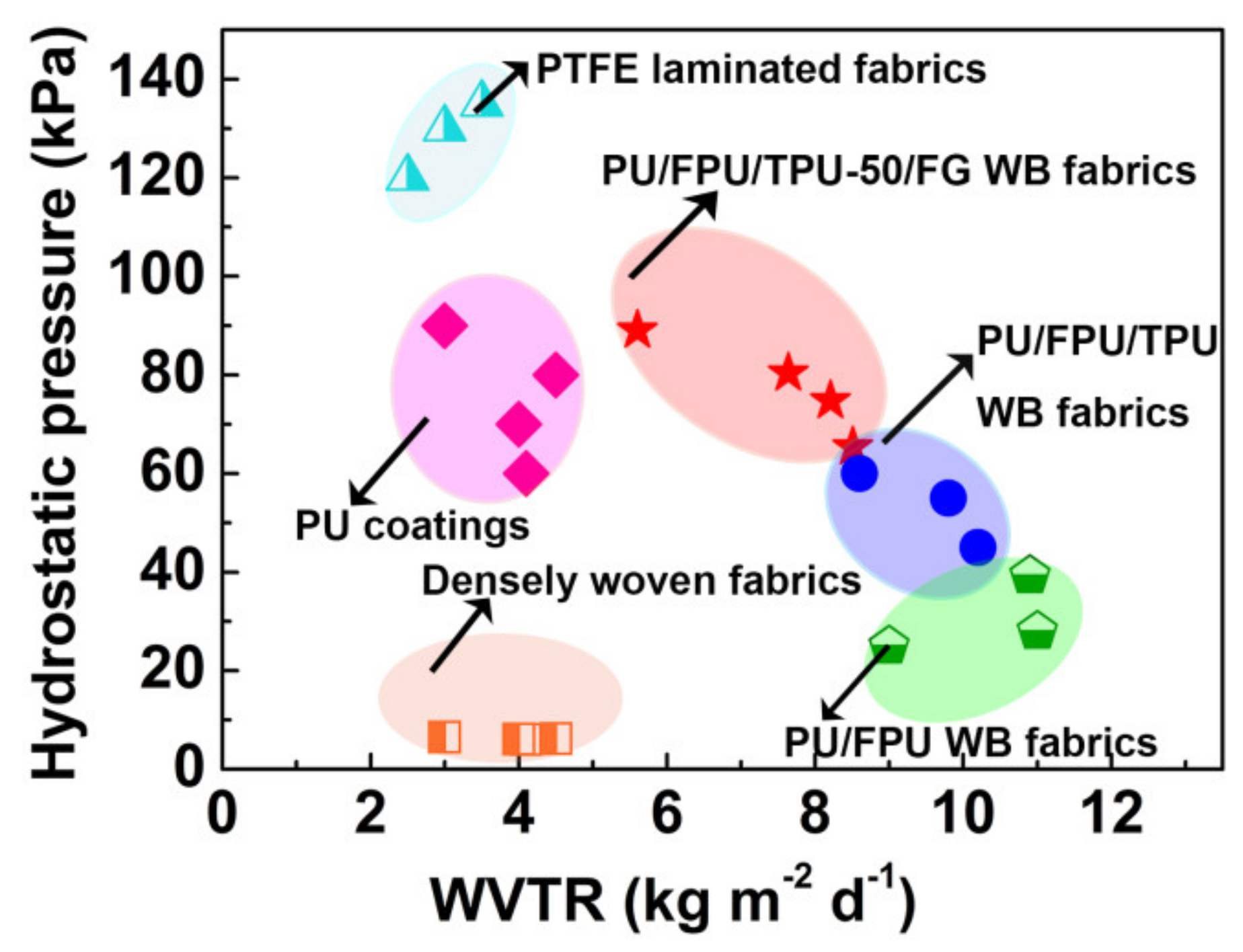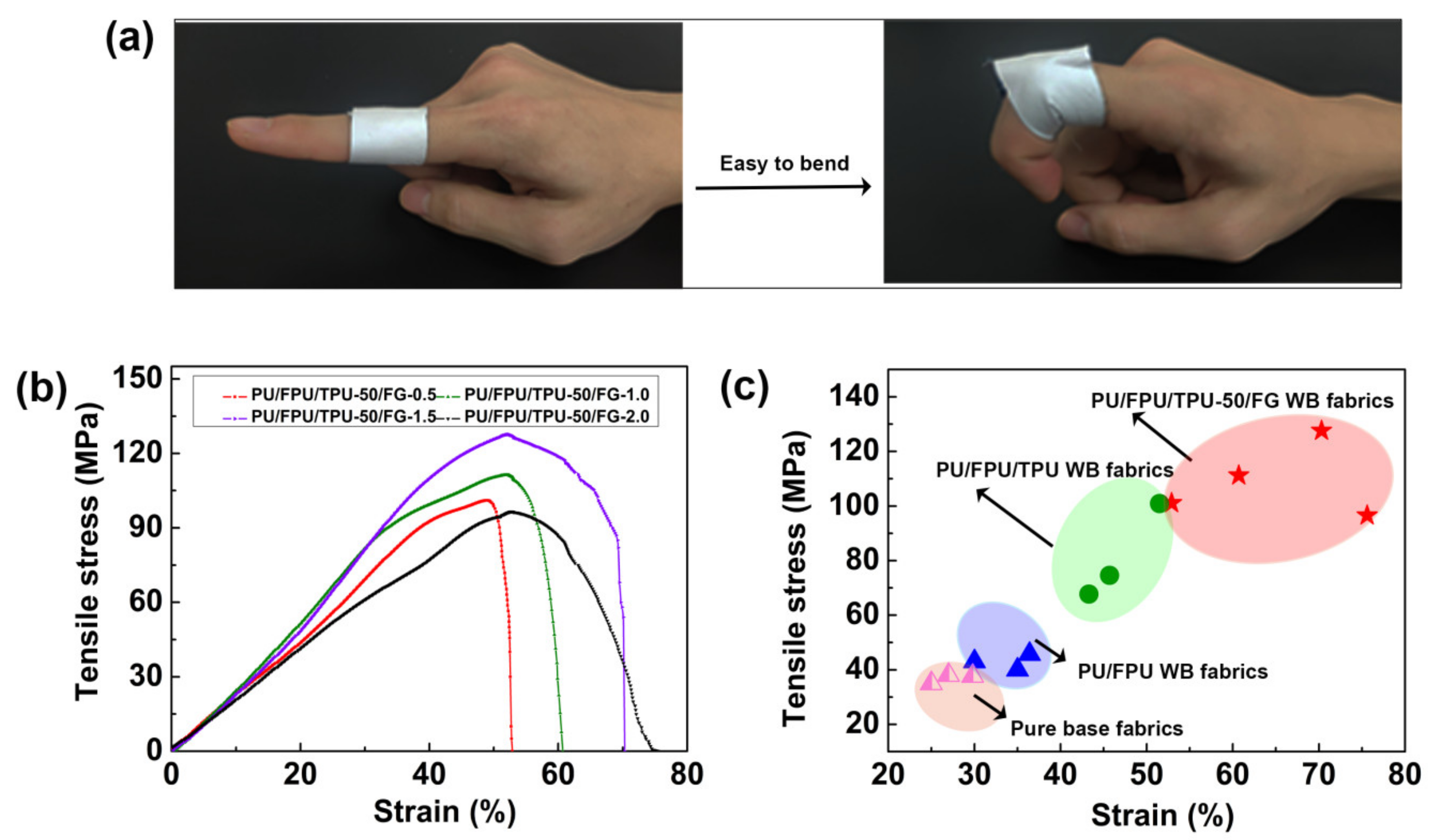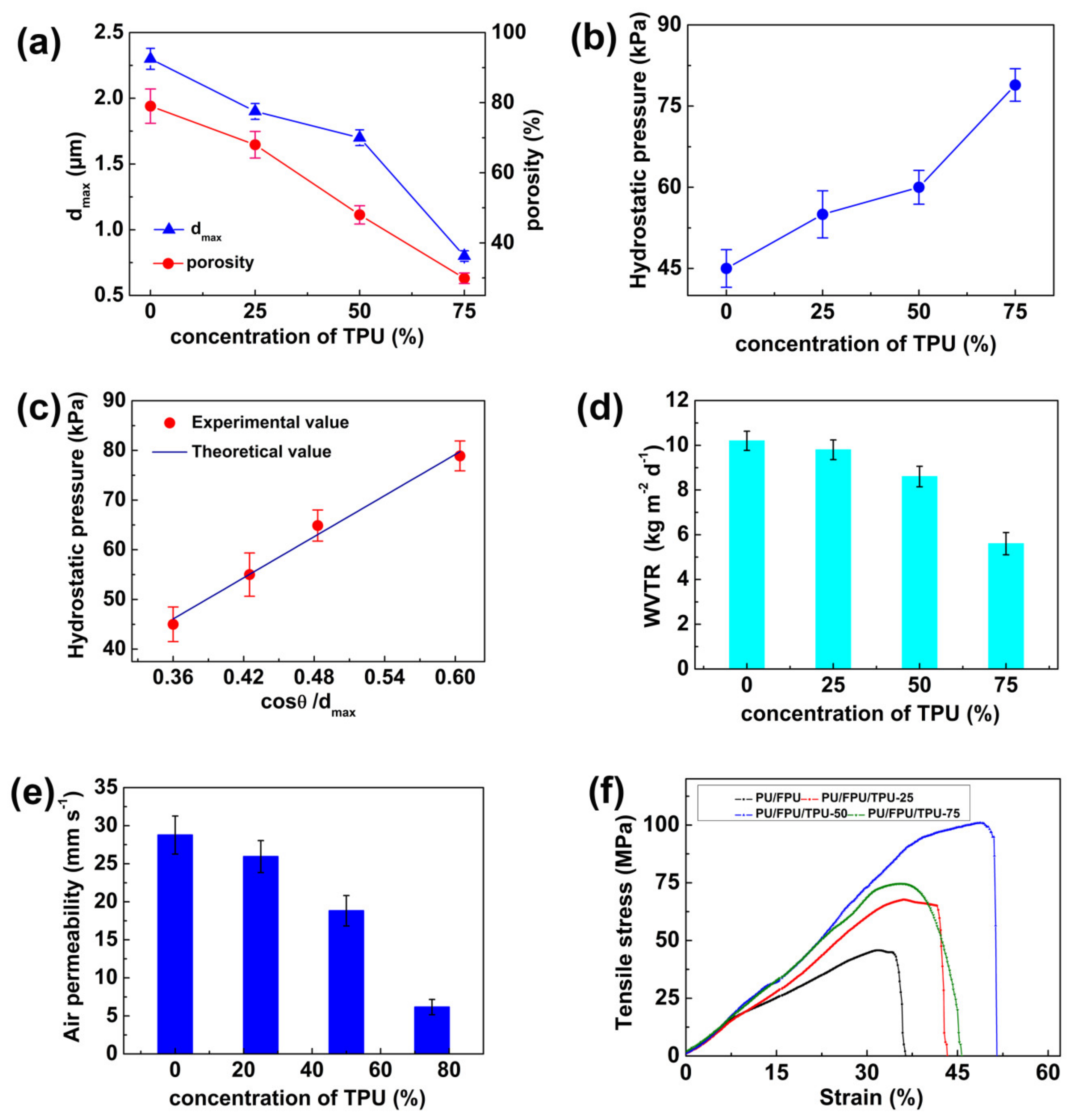Hot-melt Adhesive Bonding of Polyurethane/Fluorinated Polyurethane/Alkylsilane-Functionalized Graphene Nanofibrous Fabrics with Enhanced Waterproofness, Breathability, and Mechanical Properties
Abstract
1. Introduction
2. Materials and Methods
2.1. Materials
2.2. Preparation of FG
2.3. Preparation of PU/FPU/TPU-50/FG Nanofiber WB Fabric
2.4. Preparation of the PU/FPU/TPU Nanofiber WB Fabric
2.5. Materials Characterization
2.6. Materials Performance Testing
3. Results and Discussion
3.1. Preparation of the Nanofiber WB Fabrics
3.2. Microstructure and SURFACE Wettability of PU/FPU/TPU-50/FG Nanofiber WB Fabrics
3.3. Waterproofness, Breathability, Antifouling, and Mechanical Performance of PU/FPU/TPU-50/FG WB Fabrics
3.4. The Inter-fiber Fusion Structure of PU/FPU/TPU WB Fabrics
4. Conclusions
Supplementary Materials
Author Contributions
Funding
Conflicts of Interest
References
- Jeong, J.H.; Han, Y.C.; Yang, J.H.; Kwak, D.S.; Jeong, H.M. Waterborne polyurethane modified with poly (ethylene glycol) macromer for waterproof breathable coating. Prog. Org. Coat. 2017, 103, 69–75. [Google Scholar] [CrossRef]
- Zhao, X.; Luo, J.; Fang, C.; Xiong, J. Investigation of polylactide/poly (ε-caprolactone)/multi-walled carbon nanotubes electrospun nanofibers with surface texture. RSC Adv. 2015, 5, 99179–99187. [Google Scholar] [CrossRef]
- Baji, A.; Agarwal, K.; Oopath, S.V. Emerging Developments in the Use of Electrospun Fibers and Membranes for Protective Clothing Applications. Polymers 2020, 12, 492. [Google Scholar] [CrossRef] [PubMed]
- Ruckman, J. Water vapour transfer in waterproof breathable fabrics: Part 3: under rainy and windy conditions. Int. J. Cloth. Sci. Technol. 1997, 9, 141–153. [Google Scholar] [CrossRef]
- Ren, G.; Zhang, Z.; Zhu, X.; Men, X.; Liu, W. Influence of lubricant filling on the dry sliding wear behaviors of hybrid PTFE/Nomex fabric composite. J. Mater. Sci. 2014, 49, 3716–3724. [Google Scholar] [CrossRef]
- Li, C.; Chen, R.; Zhang, X.; Xiong, J.; Zheng, Y.; Dong, W. Fabrication and characterization of electrospun nanofibers of high DP natural cotton lines cellulose. Fiber. Polym. 2011, 12, 345–351. [Google Scholar] [CrossRef]
- Jahid, M.A.; Hu, J.; Wong, K.; Wu, Y.; Zhu, Y.; Luo, S.; Hong, H.; Zhongmin, D. Fabric coated with shape memory polyurethane and its properties. Polymers 2018, 10, 681. [Google Scholar] [CrossRef]
- Moiz, A.; Padhye, R.; Wang, X. Coating of TPU-PDMS-TMS on polycotton abrics for versatile protection. Polymers 2017, 9, 1–17. [Google Scholar] [CrossRef]
- Li, N.; Qin, X.H.; Lin, L.; Wang, S.Y. The effects of spinning conditions on the morphology of electrospun jet and nonwoven membrane. Polym. Eng. Sci. 2008, 48, 2362–2366. [Google Scholar] [CrossRef]
- Tan, K.; Obendorf, S.K. Development of an antimicrobial microporous polyurethane membrane. J. Membr. Sci. 2007, 289, 199–209. [Google Scholar] [CrossRef]
- Tan, K.; Obendorf, S.K. Surface modification of microporous polyurethane membrane with poly (ethylene glycol) to develop a novel membrane. J. Membr. Sci. 2006, 274, 150–158. [Google Scholar] [CrossRef]
- Terraza, C.A.; Martin-Trasanco, R.; Saldías, C.; González, M.; Leiva, Á.; Tundidor-Camba, A. Preparation of CuONPs@ PVDF/Non-Woven Polyester Composite Membrane: Structural Influence of Nanoparticle Addition. Polymers 2018, 10, 862. [Google Scholar] [CrossRef] [PubMed]
- Jiang, H.X.; Ni, Q.Q.; Natsuki, T. Design and evaluation of the interface between carbon nanotubes and natural rubber. Polym. Compos. 2011, 32, 236–242. [Google Scholar] [CrossRef]
- Zhang, L.; Ni, Q.Q.; Shiga, A.; Natsuki, T.; Fu, Y. Preparation of polybenzimidazole/functionalized carbon nanotube nanocomposite films for use as protective coatings. Polym. Eng. Sci. 2011, 51, 1525–1532. [Google Scholar] [CrossRef]
- Gu, X.; Li, N.; Gu, H.; Xia, X.; Xiong, J. Polydimethylsiloxane-modified polyurethane–poly (ε-caprolactone) nanofibrous membranes for waterproof, breathable applications. J. Appl. Polym. Sci. 2018, 135, 46360. [Google Scholar] [CrossRef]
- Narendar, R.; Dasan, K.P. Effect of chemical treatment on the mechanical and water absorption properties of coir pith/nylon/epoxy sandwich composites. Int. J. Polym. Anal. Charact. 2013, 18, 369–376. [Google Scholar] [CrossRef]
- Liu, C.-K.; Feng, Y.; He, H.-J.; Zhang, J.; Sun, R.-J.; Chen, M.-Y. Effect of carbonization temperature on properties of aligned electrospun polyacrylonitrile carbon nanofibers. Mater. Des. 2015, 85, 483–486. [Google Scholar] [CrossRef]
- Jiang, G.; Luo, L.; Tan, L.; Wang, J.; Zhang, S.; Zhang, F.; Jin, J. Microsphere-fiber interpenetrated superhydrophobic PVDF microporous membranes with improved waterproof and breathable performance. ACS Appl. Mater. Interfaces 2018, 10, 28210–28218. [Google Scholar] [CrossRef]
- Kitamura, T.; Okabe, S.; Tanigaki, M.; Kurumada, K.I.; Ohshima, M.; Kanazawa, S.I. Morphology change in polytetrafluoroethylene (PTFE), porous membrane caused by heat treatment. Polym. Eng. Sci. 2000, 40, 809–817. [Google Scholar] [CrossRef]
- Kang, Y.K.; Park, C.H.; Kim, J.; Kang, T.J. Application of electrospun polyurethane web to breathable water-proof fabrics. Fiber. Polym. 2007, 8, 564–570. [Google Scholar] [CrossRef]
- Ge, J.; Si, Y.; Fu, F.; Wang, J.; Yang, J.; Cui, L.; Ding, B.; Yu, J.; Sun, G. Amphiphobic fluorinated polyurethane composite microfibrous membranes with robust waterproof and breathable performances. RSC Adv. 2013, 3, 2248–2255. [Google Scholar] [CrossRef]
- Sadighzadeh, A.; Valinejad, M.; Gazmeh, A.; Rezaiefard, B. Synthesis of polymeric electrospun nanofibers for application in waterproof-breathable fabrics. Polym. Eng. Sci. 2016, 56, 143–149. [Google Scholar] [CrossRef]
- Yu, X.; Wu, X.; Si, Y.; Wang, X.; Yu, J.; Ding, B. Waterproof and breathable electrospun nanofibrous membranes. Macromol. Rapid Commun. 2019, 40, 1800931. [Google Scholar] [CrossRef] [PubMed]
- Youn, B.-R.; Lee, S.-S. Comparison of mechanical properties of electrospun nanofiber web layered systems and conventional breathable waterproof fabrics. Korean J. Sci. Emot. Sensib. 2010, 13, 391–402. [Google Scholar]
- Sheng, J.; Li, Y.; Wang, X.; Si, Y.; Yu, J.; Ding, B. Thermal inter-fiber adhesion of the polyacrylonitrile/fluorinated polyurethane nanofibrous membranes with enhanced waterproof-breathable performance. Sep. Purif. Technol. 2016, 158, 53–61. [Google Scholar] [CrossRef]
- Sumin, L.; Kimura, D.; Lee, K.H.; Park, J.; Kim, I.S. The effect of laundering on the thermal and water transfer properties of mass-produced laminated nanofiber web for use in wear. Text. Res. J. 2010, 80, 99–105. [Google Scholar] [CrossRef]
- Morel, A.; Salaün, F.; Bedek, G.; Dupont, D.; Giraud, S. Water vapor permeability of thermosensitive polyurethane films obtained from isophorone diisocyanate and polyester or polyether polyol. J. Mater. Sci. 2017, 52, 1014–1027. [Google Scholar] [CrossRef]
- Wang, T.; Huang, L.; Chen, W.; Tan, Y.; Chen, L.; Wu, D. Thermal bonded cocoon laminates via simple hot-press treatment. J. Mater. Sci. 2018, 53, 15726–15734. [Google Scholar] [CrossRef]
- Ma, W.-S.; Li, J.; Deng, B.-J.; Zhao, X.-S. Preparation and characterization of long-chain alkyl silane-functionalized graphene film. J. Mater. Sci. 2013, 48, 156–161. [Google Scholar] [CrossRef]
- Yuen, S.-M.; Ma, C.-C.M.; Chiang, C.-L. Silane grafted MWCNT/polyimide composites–Preparation, morphological and electrical properties. Compos. Sci. Technol. 2008, 68, 2842–2848. [Google Scholar] [CrossRef]
- Hemraj-Benny, T.; Wong, S.S. Silylation of single-walled carbon nanotubes. Chem. Mater. 2006, 18, 4827–4839. [Google Scholar] [CrossRef]
- Park, S.; Lee, K.-S.; Bozoklu, G.; Cai, W.; Nguyen, S.T.; Ruoff, R.S. Graphene oxide papers modified by divalent ions—enhancing mechanical properties via chemical cross-linking. ACS Nano 2008, 2, 572–578. [Google Scholar] [CrossRef] [PubMed]
- Liu, Y.; Wu, H.; Chen, G. Enhanced mechanical properties of nanocomposites at low graphene content based on in situ ball milling. Polym. Compos. 2016, 37, 1190–1197. [Google Scholar] [CrossRef]
- Crick, C.R.; Gibbins, J.A.; Parkin, I.P. Superhydrophobic polymer-coated copper-mesh; membranes for highly efficient oil–water separation. J. Mater. Chem. A 2013, 1, 5943–5948. [Google Scholar] [CrossRef]
- Spielman, L.A.; Goren, S.L. Progress in induced coalescence and a new theoretical framework for coalescence by porous media. Ind. Eng. Chem. 1970, 62, 10–24. [Google Scholar] [CrossRef]
- Cui, H.; Li, Y.; Zhao, X.; Yin, X.; Yu, J.; Ding, B. Multilevel porous structured polyvinylidene fluoride/polyurethane fibrous membranes for ultrahigh waterproof and breathable application. Compos. Commun. 2017, 6, 63–67. [Google Scholar] [CrossRef]
- Li, D.-W.; Wang, H.-Y.; Liu, Y.; Wei, D.-S.; Zhao, Z.-X. Large-scale fabrication of durable and robust super-hydrophobic spray coatings with excellent repairable and anti-corrosion performance. Chem. Eng. J. 2019, 367, 169–179. [Google Scholar] [CrossRef]
- Chen, K.; Zhou, J.; Ge, F.; Zhao, R.; Wang, C. Smart UV-curable fabric coatings with self-healing ability for durable self-cleaning and intelligent oil/water separation. Colloids Surf. Physicochem. Eng. Aspects 2019, 565, 86–96. [Google Scholar] [CrossRef]
- Chen, K.; Gou, W.; Xu, L.; Zhao, Y. Low cost and facile preparation of robust multifunctional coatings with self-healing superhydrophobicity and high conductivity. Compos. Sci. Technol. 2018, 156, 177–185. [Google Scholar] [CrossRef]
- Amini, G.; Karimi, M.; Zokaee Ashtiani, F. Hybrid electrospun membrane based on poly (vinylidene fluoride)/poly (acrylic acid)–poly (vinyl alcohol) hydrogel for waterproof and breathable applications. J. Ind. Text. 2020, 1528083720904675. [Google Scholar] [CrossRef]
- Yoon, B.; Lee, S. Designing waterproof breathable materials based on electrospun nanofibers and assessing the performance characteristics. Fiber. Polym. 2011, 12, 57–64. [Google Scholar] [CrossRef]
- Zhao, J.; Zhu, W.; Wang, X.; Liu, L.; Yu, J.; Ding, B. Fluorine-Free Waterborne Coating for Environmentally Friendly, Robust Water-Resistant, and Highly Breathable Fibrous Textiles. ACS Nano 2020, 14, 1045–1054. [Google Scholar] [CrossRef] [PubMed]
- Haselbach, W.; Lauke, B. Acoustic emission of debonding between fibre and matrix to evaluate local adhesion. Compos. Sci. Technol. 2003, 63, 2155–2162. [Google Scholar] [CrossRef]
- Cho, E.-C.; Chang-Jian, C.-W.; Chen, H.-C.; Chuang, K.-S.; Zheng, J.-H.; Hsiao, Y.-S.; Lee, K.-C.; Huang, J.-H. Robust multifunctional superhydrophobic coatings with enhanced water/oil separation, self-cleaning, anti-corrosion, and anti-biological adhesion. Chem. Eng. J. 2017, 314, 347–357. [Google Scholar] [CrossRef]
- Nakajima, A.; Hashimoto, K.; Watanabe, T.; Takai, K.; Yamauchi, G.; Fujishima, A. Transparent superhydrophobic thin films with self-cleaning properties. Langmuir 2000, 16, 7044–7047. [Google Scholar] [CrossRef]
- Yang, M.; Liu, W.; Jiang, C.; Xie, Y.; Shi, H.; Zhang, F.; Wang, Z. Facile construction of robust superhydrophobic cotton textiles for effective UV protection, self-cleaning and oil-water separation. Colloids Surf. Physicochem. Eng. Aspects 2019, 570, 172–181. [Google Scholar] [CrossRef]
- Zhang, M.; Sheng, J.; Yin, X.; Yu, J.; Ding, B. Polyvinyl butyral modified polyvinylidene fluoride breathable–waterproof nanofibrous membranes with enhanced mechanical performance. Macromol. Mater. Eng. 2017, 30, 1600272. [Google Scholar] [CrossRef]
- Sheng, J.; Zhang, M.; Luo, W.; Yu, J.; Ding, B. Thermally induced chemical cross-linking reinforced fluorinated polyurethane/polyacrylonitrile/polyvinyl butyral nanofibers for waterproof-breathable application. RSC Adv. 2016, 6, 29629–29637. [Google Scholar] [CrossRef]
- Bi, H.; Ren, Z.; Guo, R.; Xu, M.; Song, Y. Fabrication of flexible wood flour/thermoplastic polyurethane elastomer composites using fused deposition molding. Ind. Crop. Prod. 2018, 122, 76–84. [Google Scholar] [CrossRef]
- Liu, C.K.; Lai, K.; Liu, W.; Yao, M.; Sun, R.J. Preparation of carbon nanofibres through electrospinning and thermal treatment. Polym. Int. 2009, 58, 1341–1349. [Google Scholar] [CrossRef]
- Baek, W.I.; Pant, H.R.; Nirmala, R.; Nam, K.T.; Oh, H.J.; Kim, H.Y. Mechanical property enhancement of non-bonding electrospun mats via adhesive. Polym. Int. 2012, 61, 844–849. [Google Scholar] [CrossRef]
- Banea, M.D.; da Silva, L.F. Mechanical characterization of flexible adhesives. J. Adhes. 2009, 85, 261–285. [Google Scholar] [CrossRef]
- Marques, E.; da Silva, L.F.; Banea, M.; Carbas, R. Adhesive joints for low-and high-temperature use: an overview. J. Adhes. 2015, 91, 556–585. [Google Scholar] [CrossRef]








© 2020 by the authors. Licensee MDPI, Basel, Switzerland. This article is an open access article distributed under the terms and conditions of the Creative Commons Attribution (CC BY) license (http://creativecommons.org/licenses/by/4.0/).
Share and Cite
Liu, C.; Liao, X.; Shao, W.; Liu, F.; Ding, B.; Ren, G.; Chu, Y.; He, J. Hot-melt Adhesive Bonding of Polyurethane/Fluorinated Polyurethane/Alkylsilane-Functionalized Graphene Nanofibrous Fabrics with Enhanced Waterproofness, Breathability, and Mechanical Properties. Polymers 2020, 12, 836. https://doi.org/10.3390/polym12040836
Liu C, Liao X, Shao W, Liu F, Ding B, Ren G, Chu Y, He J. Hot-melt Adhesive Bonding of Polyurethane/Fluorinated Polyurethane/Alkylsilane-Functionalized Graphene Nanofibrous Fabrics with Enhanced Waterproofness, Breathability, and Mechanical Properties. Polymers. 2020; 12(4):836. https://doi.org/10.3390/polym12040836
Chicago/Turabian StyleLiu, Chunhui, Xi Liao, Weili Shao, Fan Liu, Bin Ding, Gaihuan Ren, Yanyan Chu, and Jianxin He. 2020. "Hot-melt Adhesive Bonding of Polyurethane/Fluorinated Polyurethane/Alkylsilane-Functionalized Graphene Nanofibrous Fabrics with Enhanced Waterproofness, Breathability, and Mechanical Properties" Polymers 12, no. 4: 836. https://doi.org/10.3390/polym12040836
APA StyleLiu, C., Liao, X., Shao, W., Liu, F., Ding, B., Ren, G., Chu, Y., & He, J. (2020). Hot-melt Adhesive Bonding of Polyurethane/Fluorinated Polyurethane/Alkylsilane-Functionalized Graphene Nanofibrous Fabrics with Enhanced Waterproofness, Breathability, and Mechanical Properties. Polymers, 12(4), 836. https://doi.org/10.3390/polym12040836





